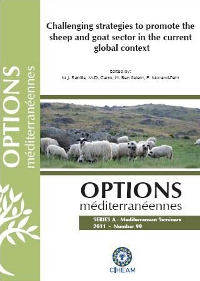| Article précédent | p. 343-348 | Article suivant |
Effect of the administration of PEG on milk yield and composition in sheep browsing a tanniniferous fodder tree
The objective of this study was to examine how the administration of a tannin-neutralising agent (polyethylene glycol, PEG) to lactating sheep browsing a tanniniferous fodder tree could affect the ewes' performance in terms of milk yield and composition. Forty lactating sheep of a local Tunisian breed (Barbarine) were used. Sheep were browsing the fodder tree Acacia cyanophylla Lindl. as their basal diet, supplemented with grass hay and concentrate. Animals were allocated in two experimental groups, namely control and PEG. Sheep of the PEG group received an oral dose of PEG 4000 (20 g/d). Milk yield was recorded the first day of treatment (P1, corresponding on average to 77 days of lactation) and then at 41 and 75 days thereafter (P2 and P3, respectively), and samples of milk were collected to determine fat, protein and urea contents. Milk yield at P1 and P3 was not affected by the administration of PEG, with average values for control and PEG groups of 799 and 854 g (SEM 111.9) at P1, and 476 and 468 g (SEM 25.9) at P3. There were differences (P = 0.007) between experimental groups in milk yield at P2, with average values of 709 and 884 g (SEM 43.4) for control and PEG ewes, respectively. Milk fat was higher at P1 and P3 (average fat content 105 g/kg) than at P2 (75 g/kg), and there were no effects (P > 0.10) of PEG supplementation on this trait. Milk protein was similar through the lactation with average protein content of 58 g/kg, and was not affected by PEG. There was not a significant effect of PEG on urea concentration in milk, which showed a noticeable variation through lactation with lowest values at P2. In conclusion, the administration of PEG to lactating sheep browsing a tanniniferous fodder tree had no effects on milk composition, but an increase in milk yield in mid lactation was observed in response to PEG, indicating that animals could benefit from higher supply of feed protein owing to the binding of Acacia tannins by this compound.
L'objectif de ce travail est de montrer comment l'administration d'un agent neutralisant des tannins (PEG) à des brebis en lactation pâturant sur maquis d'arbustes fourragers pourrait affecter leurs performances laitières en termes de rendement et de composition du lait. Quarante brebis de race Barbarine en lactation ont été utilisées. Toutes les brebis ont été mises sur un parcours d'Acacia cyanophylla Lindl. en tant qu'aliment de base, et supplémentées par le foin d'herbe et le concentré. Les animaux ont été répartis en deux groupes expérimentaux nommés contrôle et PEG. Par voie orale, les brebis du groupe PEG ont reçu une dose PEG 4000 (20 g/j). La production laitière a été mesurée le premier jour du traitement (P1, correspondant en moyenne au 77ième jour de lactation) puis au 41ième et 75ième jours suivants (P2 et P3, respectivement), des échantillons de lait ont été collectés pour déterminer les contenus en protéine, matière grasse et urée. La production laitière mesurée à P1 et P3 n'était pas affectée par l'administration du PEG, étant en moyenne, pour les deux groupes contrôle et PEG, 799 et 854 g (ESM 111,9) à P1, et 476 et 468 g (SEM 25,9) à P3. Cependant, la production laitière enregistrée à P2 a été significativement différente (P = 0,007) entre les deux groupes, avec une moyenne de 709 et 884 g (ESM 43,4) pour le groupe contrôle et PEG, respectivement. La matière grasse était plus élevée à P1 et P3 (en moyenne 105 g/kg) qu'à P2 (75 g/kg), sans qu'il y ait un effet significatif (P>0,10) du PEG sur ce paramètre. Durant toute la lactation, le contenu protéique du lait était constant (58 g/kg) et n'était pas affecté par l'addition du PEG. De même, la concentration du lait en urée n'était pas affectée par l'administration du PEG; cependant elle a marqué une variation notable tout au long de la lactation en enregistrant la valeur la plus faible à P2.
- [ Afficher ]
- [ Télécharger ]
- [ Exporter la citation ]
Vous pouvez télécharger la citation au format :
- [ Imprimer ]
-
Mots-clés
BREBIS, COMPOSITION CHIMIQUE, LAIT DE BREBIS, PLANTE A TANNIN, RENDEMENT LAITIER, NEUTRALISATIONCiter cet article
Ammar H., López S., Opsi F., Bodas R., González J.S., Andrés S. Effect of the administration of PEG on milk yield and composition in sheep browsing a tanniniferous fodder tree. In : Ranilla M.J. (ed.), Carro M.D. (ed.), Ben Salem H. (ed.), Morand-Fehr P. (ed.). Challenging strategies to promote the sheep and goat sector in the current global context. Zaragoza : CIHEAM / CSIC / Universidad de León / FAO, 2011. p. 343-348. (Options Méditerranéennes : Série A. Séminaires Méditerranéens; n. 99). 13. International Seminar of the Sub-Network on Nutrition of the FAO-CIHEAM Inter-Regional Cooperative Research and Development Network on Sheep and Goats, 2009/10/14-16, León (Spain). http://om.ciheam.org/om/pdf/a99/00801577.pdf



